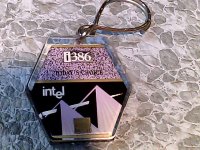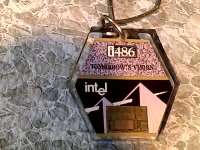So what I was thinking was something like this, you guys have the knowledge so let's write it down!
8088 to 80286 - ? % faster (if a more common comparison)
80286 to 80386 - ? % faster
80386 to 80486 - ? % faster
80486 to Pentium - ? % faster
"MIPS" is a notoriously prone-to-fudging datapoint, since it can be drastically affected by the exact instruction mix, compiler, whatever, but
Here are claimed MIPs figures for Intel CPUs from the 4004 to the Pentium 4. If we take these as ballpark figures, here's a crack at your ratios; when the same clock speed isn't available across both CPUs I'll multiply the score of the slower one by a factor corresponding with the clock speed difference.
8088 to 80286 - 3.4x faster (7mhz)*
80286 to 80386 - 1.6x (16mhz)
80386 to 80486 - 2.5x (33mhz)
80486 to Pentium - 2.24x (100mhz)
(* MIPS is claimed to be "1" for a 7mhz 80286, table claims 0.2 for a 4.8mhz 8088, 7/4.8=1.46, 0.2x1.46 = 0.29, 1/0.29=3.4. 3.4x faster per clock feels a
little high to me, but not totally out of touch with reality. The 8088/86 are *pretty slow* CPUs.)
Note the relatively small per-clock gain between the 80286 and 80386; this is why those 20mhz Harris 286s had their moment in the limelight back in the day. The problem with benchmarks like this, though, is they ignore things like how in theory at least there are programs that
can run much more efficiently on a 386 than they can on a 286 because they don't have to deal with segmented memory in protected mode... but, sure, for a DOS user this ratio is about right; 386s were mostly faster than 286s because they were clocked higher, not because the CPU was more efficient. The 486, by comparison, was a huge leap forward.
Again, in the real world these gains are too high, this is a CPU-only benchmark, and one small enough to be fooled by caching into overstating the results. When you figure in RAM speed limitations, bus constraints, etc, it was pretty rare for a 486 to
really be twice as fast as a 386 of the same clock, but in *theory* at least it was a much more efficient CPU. Although... as these figures indicate, you can make a fair case that the biggest generational improvement in Intel x86 history was between the 8088/86 to the 80286. The original x86 design *really* suffered from having to waste so many cycles using its ALU to do effective address calculations on every memory access, adding dedicated hardware for that alone was a
huge improvement.


